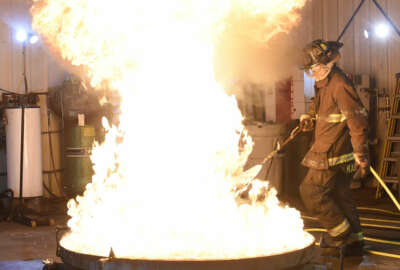
DoD says it’s ready to transition from firefighting foams that pose cancer risks by this summer
DoD says it's on a path to stop using firefighting foams linked to health risks, but fixing past problems will take a decade or more.
The Defense Department says it’s just a few months away from starting to transition itself from firefighting substances that have contaminated groundwater with harmful chemicals at and around hundreds of current and former bases, and plans to switch completely to alternative foams that don’t pose health and environmental risks by the end of this fiscal year.
The chemicals at issue — per- and polyfluoroalkyl substances, known most commonly by the acronym PFAS — can come from various sources. But in the military’s case, the main cause of water contamination has been aqueous film-forming foam (AFFF), which DoD developed in the 1960s and has been using as a fire extinguishing agent ever since.
In January, under orders from Congress, the department published its first-ever military specification for firefighting foam that doesn’t contain the chemicals of concern, which have been linked to increased risks for cancer, developmental delays, and possible damage to people’s reproductive and immune systems.
“Congressional authorizations and appropriations made it possible for the department to continue its ongoing work to evaluate fluorine-free alternatives, and several fluorine-free foams are currently proceeding through the military specification qualification process,” Brendan Owens, the assistant secretary of Defense for installations, energy and environment told the House Armed Services Committee this week. “While we implement new technology to avert future risk, we continue our cleanup efforts intended to safeguard the health and wellbeing of our people.”
So far, the department has identified more than 700 military bases where there have been known or suspected releases of PFAS-containing foams over the years. Most of those cases have been connected to firefighting training. The military services say they’ve since stopped using the PFAS-containing chemicals for anything other than genuine emergency situations while they wait for PFAS-free alternatives to arrive.
According to an analysis of DoD’s data last year by the Environmental Working Group, 389 sites have had PFAS detected in nearby groundwater, and 266 of those have contamination levels above what the EPA considers unsafe.
Out of all the services, the Army has the most sites where contamination is suspected: 341 out of the 700 total. Officials testified this week that the initial phase of the investigation has only been finished at 180 of those locations; 80 have moved on to a more “advanced” phase of the investigation.
But Owens said DoD is committed to cleanup too.
“It’s vitally important that the full department takes its responsibility to deal with the legacies of the decisions that we’ve made,” he said.
Congress has been pressing the department for several years to deal with the PFAS problem. The 2020 Defense authorization act gave DoD until October of this year to stop using firefighting foam that contains PFAS chemicals.
And although investigative work is ongoing, the cleanup process is taking too long, said Rep. Don Davis (D-N.C.).
“Unfortunately, Camp Lejeune has a long history of service members being harmed by environmental contaminations, specifically dealing with water,” he said. “DoD has indicated that while the Navy has begun the process, phase two of the process of the remedial investigation and feasibility study will not be completed until the last quarter of fiscal year 2029, which means we’re probably looking at 2030 before a meaningful cleanup.”
According to a report the department submitted to Congress last July, the timeline is similar across the country: Timeframes in the range of 2029 through 2031 are only the dates by which DoD expects to finish its investigations on what remediation work will be necessary, and target dates to actually accomplish the cleanup across sites that are found to be contaminated haven’t been set yet.
The same report shows DoD has spent $1.5 billion on its investigation efforts so far, and that the department expects future investigation and cleanup costs to be about $2.8 billion, based on its current understanding of the scale of the problem.
But the Government Accountability Office warned in a 2021 report that the true, long-term costs for remediating the PFAS situation were masked by the fact that the department doesn’t have anything close to a full understanding of the degree to which its past activities have contaminated local water sources, yet alone the costs of the engineering and other on-the-ground work that would be needed to adequately solve the problem.
Rep. Gabe Vasquez (D-N.M.) said he’s seen a pattern of DoD being slow to remediate its past environmental mistakes.
“As a former city councilor in Las Cruces, New Mexico, where the National Guard was found liable for contaminants that cost the city $6 million, we had to go to court to get an order to clean up the contaminants that were found by the EPA to be in the drinking water of our residents. That was an unacceptable response from the Department of Defense,” he said. “It is very hard to attract service members and families to the missions at Holloman Air Force Base when there is a danger that they will be ingesting toxic chemicals from buildings that have asbestos and other chemicals that have yet to be remediated, despite the record investments that we have made in our defense budget year after year. I think this is a critical readiness component.”
Copyright © 2025 Federal News Network. All rights reserved. This website is not intended for users located within the European Economic Area.
Jared Serbu is deputy editor of Federal News Network and reports on the Defense Department’s contracting, legislative, workforce and IT issues.
Follow @jserbuWFED
Related Stories





